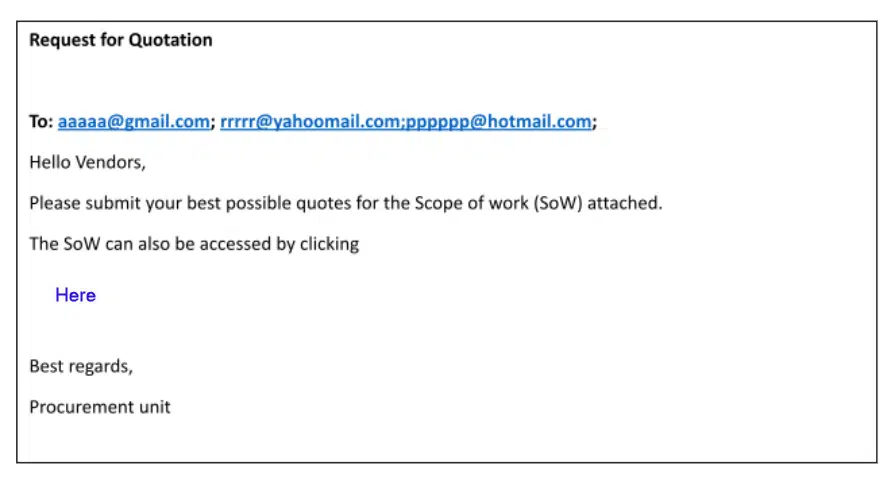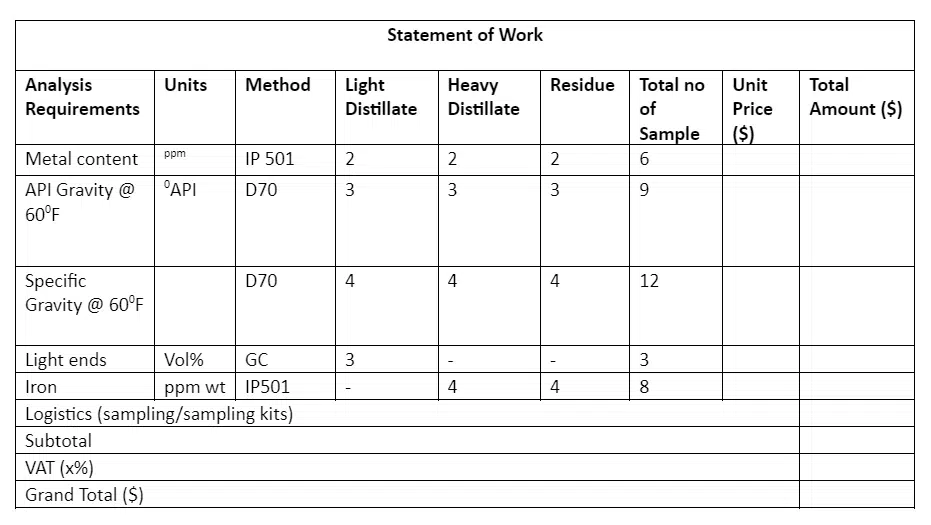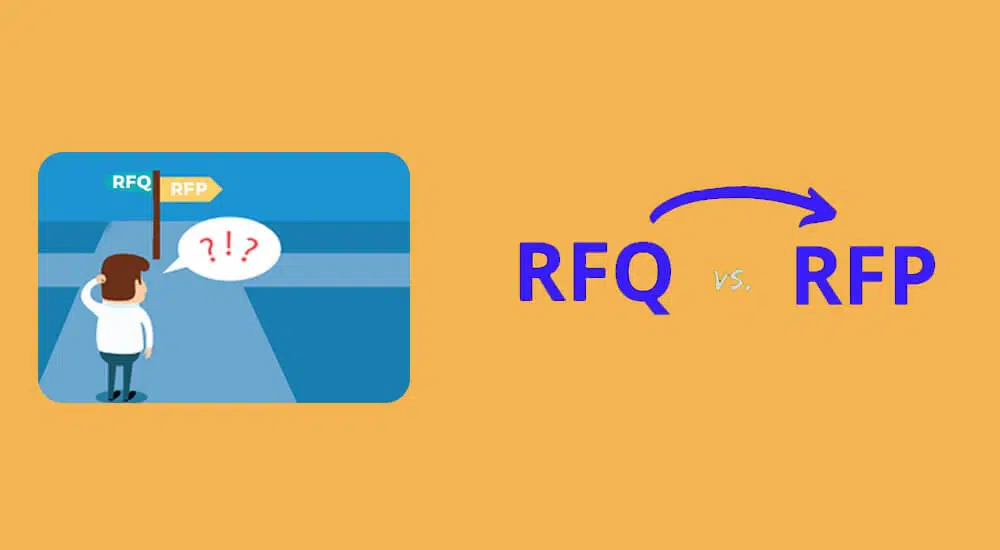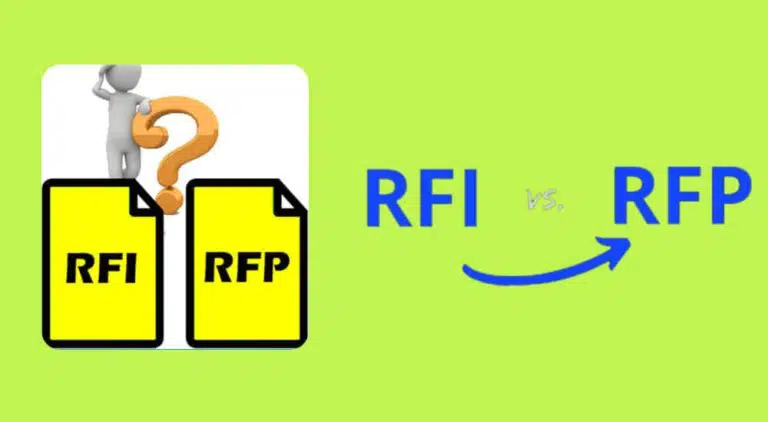RFQ and RFP are key procurement documents. We will discuss RFQ Vs RFP in today’s post.
Project procurement management helps the team source materials, equipment, labor, and services required for project completion.
For solution-based requirements, you should use a request for a proposal.
But if you need to buy commodities and consumables with well-defined specifications, an RFQ is the document you need.
Let’s dive in deeper.
RFQ Vs RFP
We will start this comparison with a review of RFQ.
RFQ
An RFQ stands for Request for Quotation and is used when the price is the deciding factor and the requirements are available. It is best suited for standardized consumables, commodities, and services.
The objective is to buy commodities quickly. Often, the contract is awarded to the lowest bidder if the offer is technically acceptable.
An RFQ is sometimes called an Invitation for Bid (IFB).
The buyer provides details or specifications for the item/services so the supplier can quote a price.
Example of an RFQ

The statement of work can be as follows:

The contractor must complete the table and submit it with the bid.
The bid details can include:
- Payment Terms: Usually, payment will be within 30 days of acceptance.
- Price Validity: The RFQ will include the duration of price validity, e.g., the price will be valid for 90 days.
- Currency: Quoted currency must be in USD.
- Submission of the Bid Document and Closing Date: You must submit your bid via email to [email protected] no later than April 10th, 2022, by 1:00 pm.
RFP
An RFP stands for Request for Proposal, and you use it when the buyer has a problem and lacks the skills and resources to solve it. They require a solution from vendors. Vendors must offer creative and innovative solutions to win the award.
An RFP is common with consultancies, services, and complex projects. Normally, an expression of interest is published on the organization’s website or in a national newspaper to attract interested bidders. In addition, the buyers may select contractors (selective tendering) and invite them to submit a bid.
You can convert an RFP to a cost-reimbursable or a time and material type of contract.
Content of an RFP
- Name and address of the buyers or procurement entity (PE).
- Preferred language of the proposal (English, Spanish, etc.).
- The manner, place, and deadline for bid submission.
- A statement that the buyer reserves the right to reject any proposal.
- Criteria and procedures for the evaluation of the qualifications of the consultants.
- Qualifications of consultants with documentary evidence—you do not want to hand your procurement to an incompetent vendor.
- Nature of services, including location and time when they provide the services.
- Preferred currency of the proposal (USD, Japanese Yen, etc.).
- Instructions that only one quote be submitted to avoid disqualification.
- Statement on whether the price consists of logistics, insurance, duties, and tax.
- The basis for selecting successful proposals—could be the least cost, quality, or a combination of both.
All offers are technically and commercially evaluated. In most cases, the selection is based on the pricing. The bid with the lowest offer gets the award.
The bidder’s selection criteria may include:
- The number of years in the industries or financial stability.
- Understanding of need.
- Technical ability.
- Project management skills.
- Price or life cycle cost.
- Quality of past performance.
- Ability to complete work on time.
An RFP lets the project management team acquire better services beyond the capabilities of internal resources.
So, the RFP provides an easy route to get the best solution.
An Example of an RFP
An RFP is a multi-page document containing the details discussed above. In addition, buyers can organize a bidders’ conference where sellers can ask questions and get answers.
Comparison Between an RFQ and RFP

FAQ on RFQ Vs RFP
Does RFQ or RFP Come First?
You can use an RFQ and RFP for different purposes, and they do not have any relation with each other.
When would you use an RFQ instead of an RFP?
You use an RFQ to buy commodities and an RFP when you require a complete solution.
When would you use an RFP Instead of an RFQ?
To buy services and projects, you use an RFP instead of an RFP.
Is an RFQ a Bid?
Yes, an RFQ is a bid, and vendors and manufacturers can bid.
Is an RFP a Bid?
Yes, an RFP is a bid, and contractors and other organization can submit their proposals.
Summary
Most projects require procurement. An organization can use RFQs and RFPs depending on requirements and complexities. The objective is to create a complete bid document with the required information so bidders can quote correctly and organizations get the necessary solutions.
References
- https://www.pmi.org/learning/library/project-requirements-rfps-vendor-proposals-6673
- https://www.bpp.gov.ng/wp-content/uploads/2019/01/Public-Procurement-Act-2007pdf.pdf
- Specialized Management Group PMP CAPM Exam Preparation Course Material, Section 9, pg. 7, 18.
- PMBOK Guide, Project Management Institute, Seventh edition, pg. 74-75
- https://www.negotiations.com/articles/procurement-terms/
- https://constructioncoverage.com/glossary/request-for-information
- https://en.wikipedia.org/wiki/Request_for_proposal

I am Mohammad Fahad Usmani, B.E. PMP, PMI-RMP. I have been blogging on project management topics since 2011. To date, thousands of professionals have passed the PMP exam using my resources.







